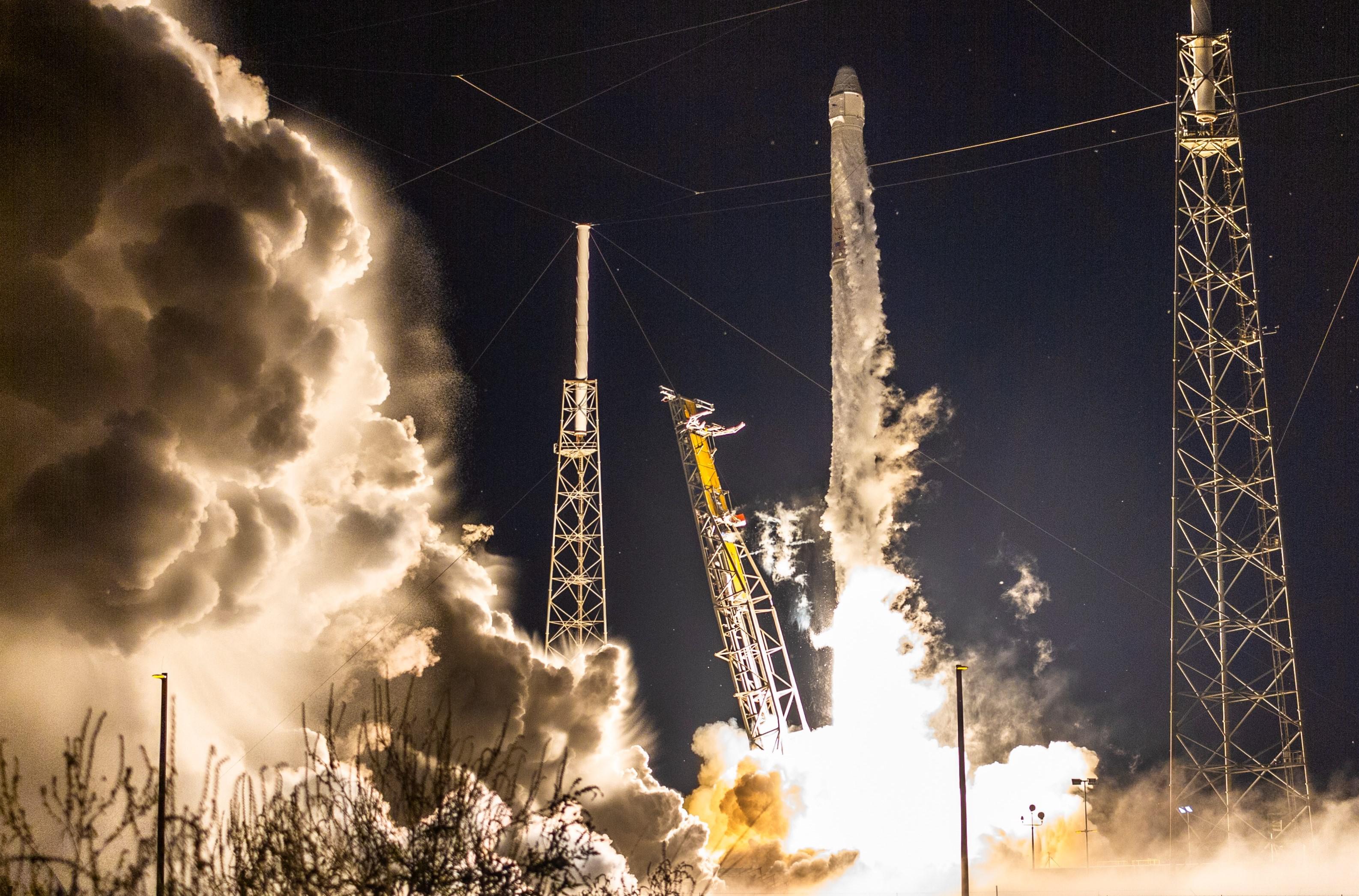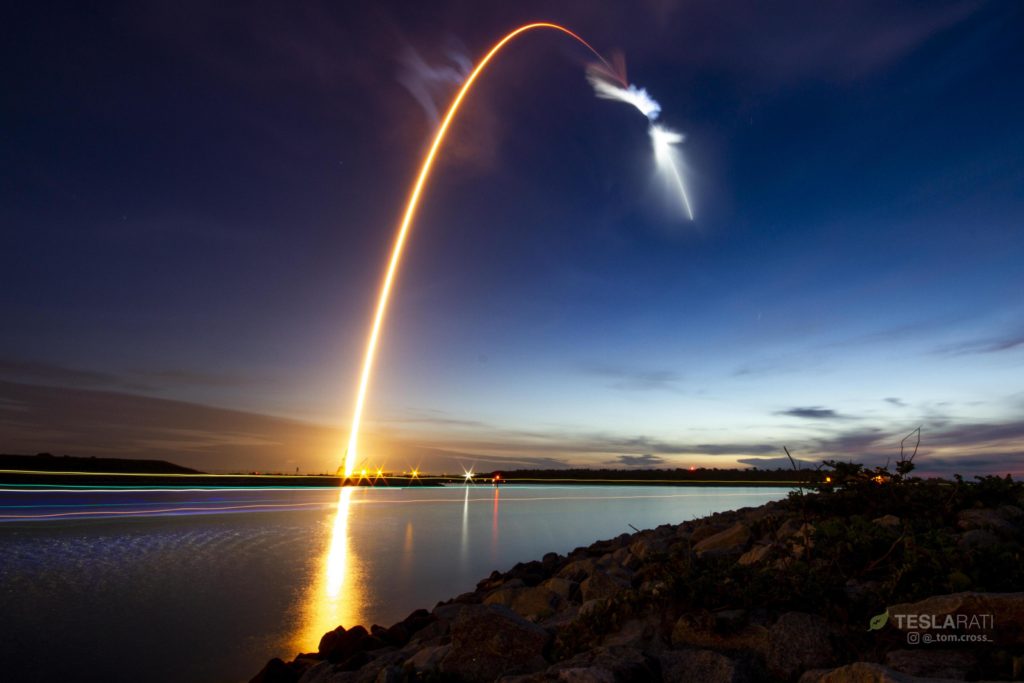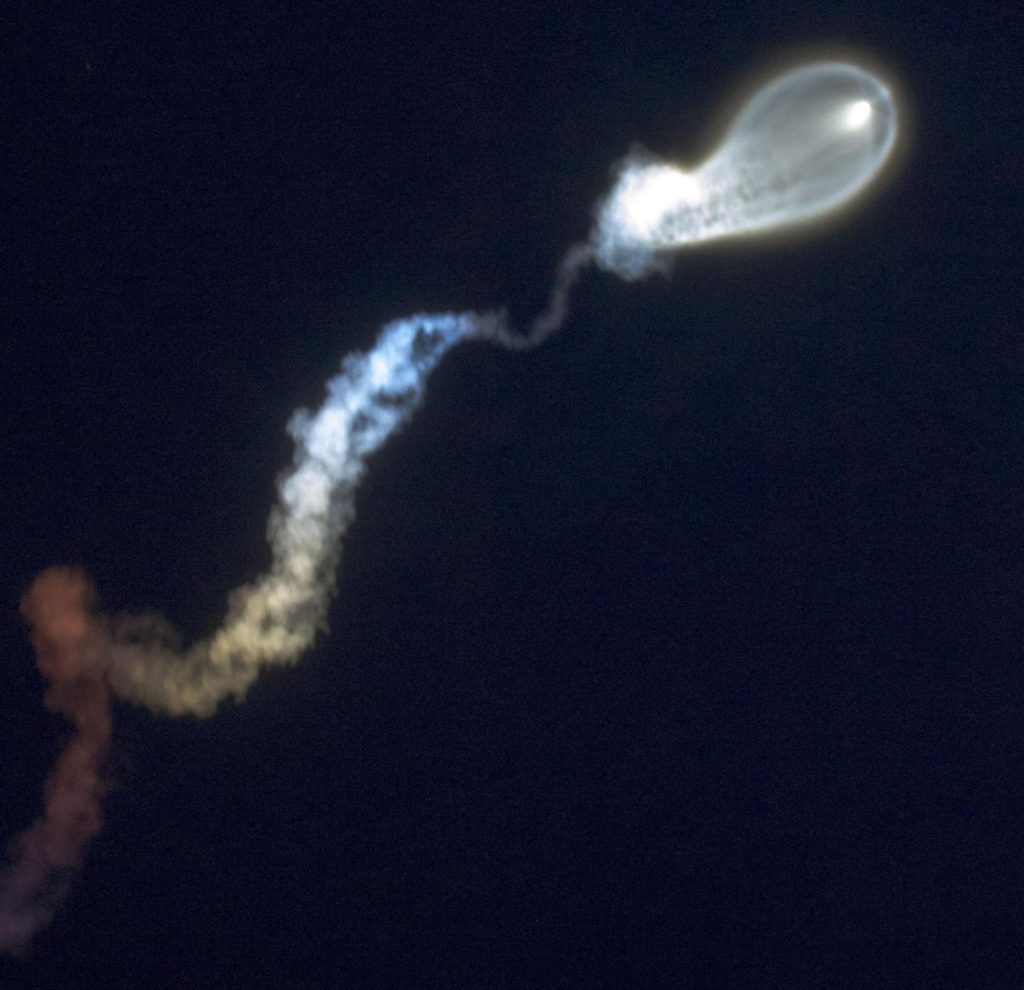

News
SpaceX bids goodbye to older Falcon 9s with Florida ‘jellyfish’ launch spectacle
SpaceX’s final Block 4 Falcon 9 has completed its second and last orbital mission with a spectacular sendoff visible for hundreds of miles along the East Coast, harkening back to “alien invasion” comparisons that followed an equally stunning SpaceX launch from California last December.
Although the Falcon 9 booster was expended in the Atlantic Ocean minutes after launch, its upper stage remains in orbit in an experimental test of its lifespan, while the mission’s flight-proven Cargo Dragon spacecraft separated from the rocket and headed to the International Space Station with a promise of a possible third orbital reuse in 2019. This mission’s Dragon capsule flew for the first time in late 2016 for the CRS-9 mission and spent the two years since then having its heat shield and other major components refurbished or replaced, likely at a cost to SpaceX less than half that of constructing a brand-new Dragon spacecraft.

Falcon 9 B1045 lounges in the Florida summer humidity, hours before its second and final launch. (Tom Cross)
According to Jessica Jensen, SpaceX’s Director of Dragon Mission Management, SpaceX’s Dragon refurbishment team has also gotten considerably more efficient over several years of experience reusing the orbital spacecraft, now up to three reflights of three separate capsules. She noted in the postlaunch conference that – if all major components are healthy upon CRS-15’s early-August return to Earth – this capsule could be refurbished for its third mission in as few as months, which would make it one of the last Dragon 1 launches before the upgraded Dragon 2 begins crewed flights and takes over all cargo missions. After CRS-15, five more of those Cargo Dragon flights remain until CRS-2’s 2020 takeover, all of which will utilize flight-proven capsules.
- CRS-15’s dramatic pre-dawn launch. (Tom Cross)
- The extraordinary plume was lit up by the sun before it had risen above the Eastern horizon. (Tom Cross)
Falcon 9, on the other hand, reached a truly historic milestone today for SpaceX – B1045’s second and final flight marks the last rocket SpaceX will fly that does not feature a number of upgrades designed to dramatically improve booster reusability. Known as Falcon 9 Block 5, all future SpaceX missions (at least until BFR’s debut sometime in the early 2020s) will be launched aboard the upgraded rocket. If it works as intended, Block 5 should theoretically enable a rapid and affordable level of reusability never before achieved by Falcon 9 or any other rocket, for that matter.
https://twitter.com/_TomCross_/status/1012694524987092992
While still more than a little disheartening to see a Falcon 9 booster intentionally expended after launch, the spectacle created by B1045’s final flight was fitting, to say the least. Thankfully, the Block 5 takeover of all future SpaceX Falcon 9 and Falcon Heavy launches is likely to also result in a dramatic reduction in SpaceX’s willingness to expend flight-proven rockets after launch. Whereas Block 3 and 4 Falcon 9s were never designed to affordably and safely fly more than two or three times total, minimizing any opportunity cost from expending twice-flown rockets after launch, Block 5 has been purpose-built to allow individual boosters to fly a bare minimum of 10 times with minimal refurbishment and as many as 100 times with regular maintenance. Unless Block 5’s design fails to achieve that level of reusability, SpaceX is extremely unlikely to expend Block 5 boosters unless they have flown a number of times to extract as much value as possible from them.
Up next on SpaceX’s manifest are two back-to-back Falcon 9 Block 5 launches, Iridium-7 from California on July 20 and Telstar 19V from Florida less than 18 hours later. Both Block 5 boosters will be recovered aboard SpaceX’s fleet of drone ships, Just Read The Instructions (JRTI) to the West and Of Course I Still Love You (OCISLY) to the East.
Follow us for live updates, peeks behind the scenes, and photos from Teslarati’s East and West Coast photographers.
Teslarati – Instagram – Twitter
Tom Cross – Twitter
Pauline Acalin – Twitter
Eric Ralph – Twitter
News
Tesla begins Robotaxi certification push in Arizona: report
Tesla seems serious about expanding its Robotaxi service to several states in the coming months.

Tesla has initiated discussions with Arizona transportation regulators to certify its driverless Robotaxi service in the state, as per a recent report from Bloomberg News. The move follows Tesla’s launch of its Robotaxi pilot program in Austin, Texas, as well as CEO Elon Musk’s recent comments about the service’s expansion in the Bay Area.
The Arizona Department of Transportation confirmed to Bloomberg that Tesla has reached out to begin the certification process for autonomous ride-sharing operations in the state. While details remain limited, the outreach suggests that Tesla is serious about expanding its driverless Robotaxi service to several territories in the coming months.
The Arizona development comes as Tesla prepares to expand its service area in Austin this weekend, as per CEO Elon Musk in a post on X. Musk also stated that Tesla is targeting the San Francisco Bay Area as its next major market, with a potential launch “in a month or two,” pending regulatory approvals.
Tesla first launched its autonomous ride-hailing program on June 22 in Austin with a small fleet of Model Y vehicles, accompanied by a Tesla employee in the passenger seat to monitor safety. While still classified as a test, Musk has said the program will expand to about 1,000 vehicles in the coming months. Tesla will later upgrade its Robotaxi fleet with the Cyercab, a two-seater that is designed without a steering wheel.
Sightings of Cybercab castings around the Giga Texas complex suggests that Tesla may be ramping the initial trial production of the self-driving two-seater. Tesla, for its part, has noted in the past that volume production of the Cybercab is expected to start sometime next year.
In California, Tesla has already applied for a transportation charter-party carrier permit from the state’s Public Utilities Commission. The company is reportedly taking a phased approach to operating in California, with the Robotaxi service starting with pre-arranged rides for employees in vehicles with safety drivers.
News
Tesla sets November 6 date for 2025 Annual Shareholder Meeting
The automaker announced the date on Thursday in a Form 8-K.

Tesla has scheduled its 2025 annual shareholder meeting for November 6, addressing investor concerns that the company was nearing a legal deadline to hold the event.
The automaker announced the date on Thursday in a Form 8-K submitted to the United States Securities and Exchange Commission (SEC). The company also listed a new proposal submission deadline of July 31 for items to be included in the proxy statement.
Tesla’s announcement followed calls from a group of 27 shareholders, including the leaders of large public pension funds, which urged Tesla’s board to formally set the meeting date, as noted in a report from The Wall Street Journal.
The group noted that under Texas law, where Tesla is now incorporated, companies must hold annual meetings within 13 months of the last one if requested by shareholders. Tesla’s previous annual shareholder meeting was held on June 13, 2024, which placed the July 13 deadline in focus.
Tesla originally stated in its 2024 annual report that it would file its proxy statement by the end of April. However, an amended filing on April 30 indicated that the Board of Directors had not yet finalized a meeting date, at least at the time.
The April filing also confirmed that Tesla’s board had formed a special committee to evaluate certain matters related to CEO Elon Musk’s compensation plan. Musk’s CEO performance award remains at the center of a lengthy legal dispute in Delaware, Tesla’s former state of incorporation.
Due to the aftermath of Musk’s legal dispute about his compensation plan in Delaware, he has not been paid for his work at Tesla for several years. Musk, for his part, has noted that he is more concerned about his voting stake in Tesla than his actual salary.
At last year’s annual meeting, TSLA shareholders voted to reapprove Elon Musk’s compensation plan and ratified Tesla’s decision to relocate its legal domicile from Delaware to Texas.
Elon Musk
Grok coming to Tesla vehicles next week “at the latest:” Elon Musk
Grok’s rollout to Tesla vehicles is expected to begin next week at the latest.

Elon Musk announced on Thursday that Grok, the large language model developed by his startup xAI, will soon be available in Tesla vehicles. Grok’s rollout to Tesla vehicles is expected to begin next week at the latest, further deepening the ties between the two Elon Musk-led companies.
Tesla–xAI synergy
Musk confirmed the news on X shortly after livestreaming the release of Grok 4, xAI’s latest large language model. “Grok is coming to Tesla vehicles very soon. Next week at the latest,” Musk wrote in a post on social media platform X.
During the livestream, Musk and several members of the xAI team highlighted several upgrades to Grok 4’s voice capabilities and performance metrics, positioning the LLM as competitive with top-tier models from OpenAI and Google.
The in-vehicle integration of Grok marks a new chapter in Tesla’s AI development. While Tesla has long relied on in-house systems for autonomous driving and energy optimization, Grok’s integration would introduce conversational AI directly into its vehicles’ user experience. This integration could potentially improve customer interaction inside Tesla vehicles.
xAI and Tesla’s collaborative footprint
Grok’s upcoming rollout to Tesla vehicles adds to a growing business relationship between Tesla and xAI. Earlier this year, Tesla disclosed that it generated $198.3 million in revenue from commercial, consulting, and support agreements with xAI, as noted in a report from Bloomberg News. A large portion of that amount, however, came from the sale of Megapack energy storage systems to the artificial intelligence startup.
In July 2023, Musk polled X users about whether Tesla should invest $5 billion in xAI. While no formal investment has been made so far, 68% of poll participants voted yes, and Musk has since stated that the idea would be discussed with Tesla’s board.
-

 Elon Musk1 week ago
Elon Musk1 week agoTesla investors will be shocked by Jim Cramer’s latest assessment
-

 Elon Musk3 days ago
Elon Musk3 days agoElon Musk confirms Grok 4 launch on July 9 with livestream event
-

 Elon Musk17 hours ago
Elon Musk17 hours agoxAI launches Grok 4 with new $300/month SuperGrok Heavy subscription
-

 News7 days ago
News7 days agoTesla Model 3 ranks as the safest new car in Europe for 2025, per Euro NCAP tests
-

 Elon Musk2 weeks ago
Elon Musk2 weeks agoA Tesla just delivered itself to a customer autonomously, Elon Musk confirms
-

 Elon Musk1 week ago
Elon Musk1 week agoxAI’s Memphis data center receives air permit despite community criticism
-

 Elon Musk2 weeks ago
Elon Musk2 weeks agoTesla’s Omead Afshar, known as Elon Musk’s right-hand man, leaves company: reports
-

 News2 weeks ago
News2 weeks agoXiaomi CEO congratulates Tesla on first FSD delivery: “We have to continue learning!”





















